Family : Anarhichadidae

Text © Giuseppe Mazza

English translation by Mario Beltramini

Anarhichas lupus lives in Northeast Atlantic, from Spitsbergen islands to Scandinavia and the North Sea, south of Greenland and Canada up to Cape Cod, USA © Mary Wholey
Inserted in the class of the Actinopterygii, the ray-finned fish, the Atlantic wolffish (Anarhichas lupus Linnaeus, 1758) stands among the biggest members of the order of the Blenniiformes with about 1,5 m of length.
It belongs to the family of the Anarhichadidae that counts only 5 species including the analogous Bering wolffish (Anarhichas orientalis) that lives in the North Pacific.
Fish that at first sight would seem to be giant blennies, by some taxonomists still inserted, like upon a time, among the Perciformes with the status of suborder.
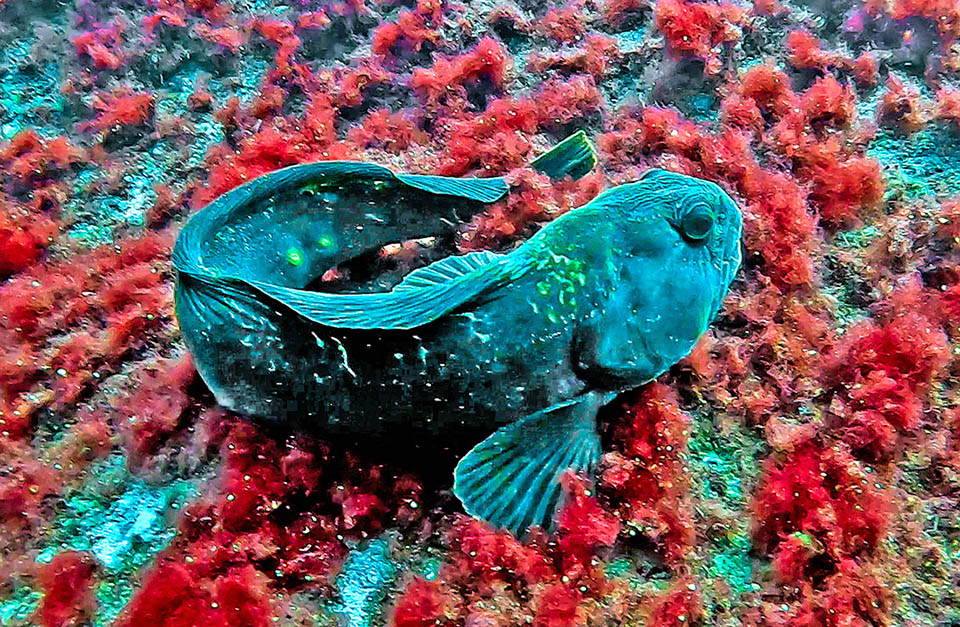
Long about 1,5 m, it would be considered a giant blenny and in fact stands among the biggest members of the Blenniiformes order © laszlocserhazi
The name of the genus Anarhichas comes from the Greek “ανα” (ana), up, and “αρρίχομάί” (arrichomai), to scramble, i.e. to climb, with reference to the old belief that for spawning these fish should climb out of water on the rocks, like Alticus saliens, using tail and fins.
Or, more simply, one would think that they use them for climbing when they go up from the rocky caves under the boulders where they spend most of the day.
Conversely, the specific term lupus, wolf in Latin, is a clear reference to the terrifying canines protruding from the jaws.
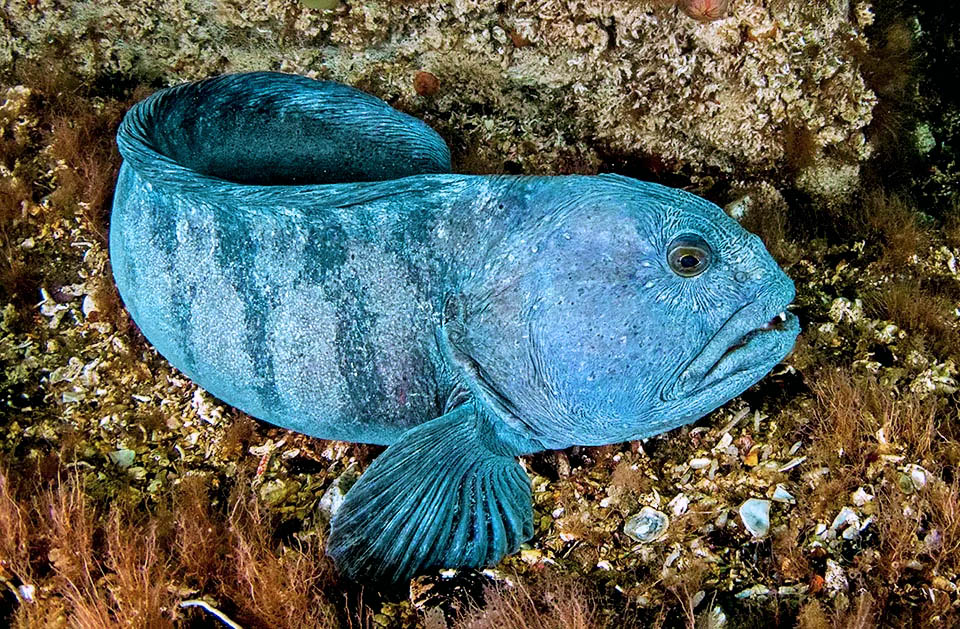
It has never bitten any diver, but due to its large canines is called Atlantic wolffish, like its congener Bering wolffish (Anarhichas orientalis) of Arctic Pacific © Poul-Erik-Rasmussen
Zoogeography
Anarhichas lupus lives in the Northeast Atlantic from the Spitsbergen up to Scandinavia and North Sea, and south of Greenland and Canada up to Cape Cod, Massachusetts.
Ecology-Habitat
The Atlantic wolffish is an oceanodromous demersal species mostly on the rocky bottoms between 1-600 m of depth with a record of 918m, but is usually found between 18 and 110 m.

The fangs, that renew every year, actually serve to break the crustaceans carapaces, the shells of the bivalves and the dermoskeleton of the sea urchins © Jim Greenfield
Morphophysiology
Anarhichas lupus reaches the length of 150 cm with a published maximum weight of 23,6 kg.
The body is generally slate blue, but also brown, green or grey depending on the surrounding environment, with dark vertical bands and light spots arranged in rays around the eyes.
The oval body, scaleless, ends with a big mouth with fleshy lips having 10-12 sharp conical fangs that renew each year just before the reproductive period, followed later by molar-shaped teeth and bony plates on the palate for grinding prey.
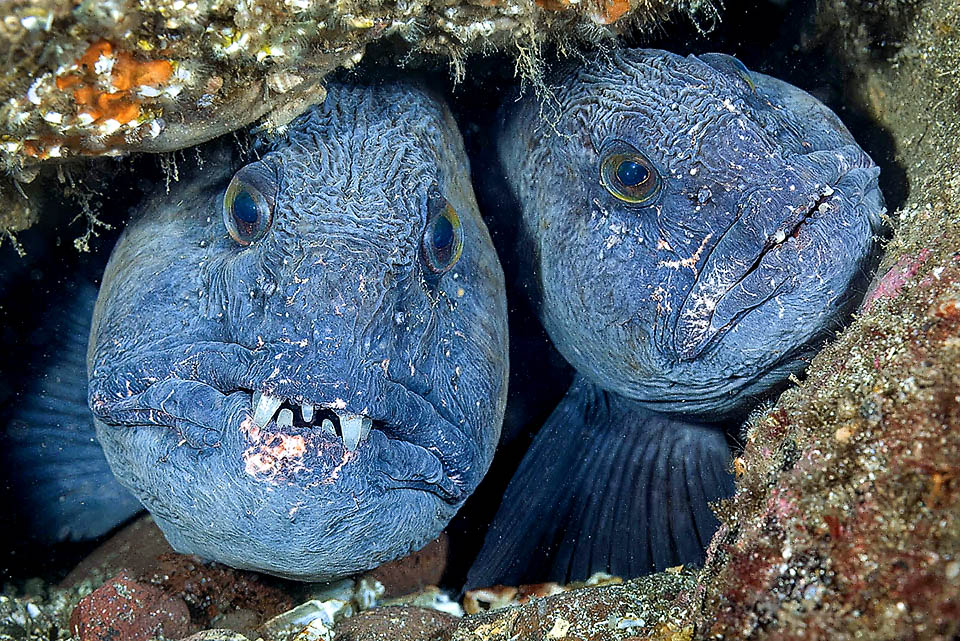
A couple in their den. Between August and September, Anarhichas lupus, which can search for prey on the seabed up to 918 m, moves to shallow waters to spawn © Jim Greenfield
Besides catching fish, sea stars and molluscs, they mainly serve to crush the shells of the bivalves, the carapace of lobsters, crabs and hermit crabs and the dermoskeleton of the sea urchins.
The very long dorsal fin reaches almost the caudal. The anal is shorter; the pelvics are missing and the caudal is small and rounded.
Ethology-Reproductive Biology
Anarhichas lupus is a calm and curious fish that allows divers to approach it and in spite of the size and the creepy canines has never caused any accidents.
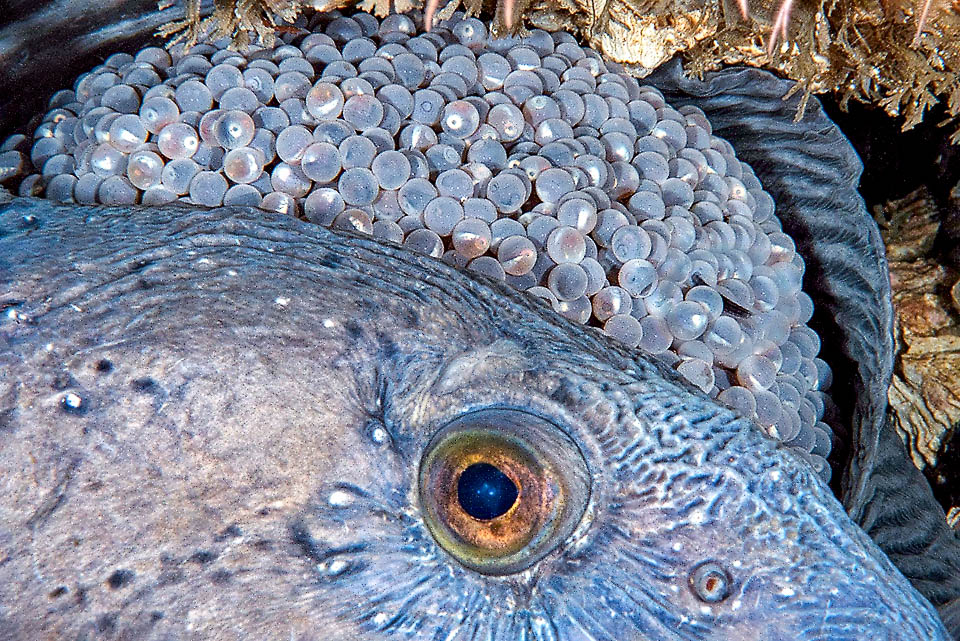
The eggs, even 6,5 mm wide, stand among the largest of the fish world, and stuck together form a ball on the seabed. Surveyed by the male they hatch after 3 months © Vebjørn Karlsen
The sexual maturity is reached at 8-10 years, when they exceed 50 cm, and is a fish that in nature lives about 20 years and in captivity more than 50.
Between August and September the couples of the Atlantic wolffish, that often share the same den, move for spawning in shallow waters.
The eggs, even 6,5 mm wide, stand along the largest eggs in the fish world, and stuck together form a sort of ball on the seabed surveyed by the male. They hatch after 3 months freeing 18 mm pelagic larvae.
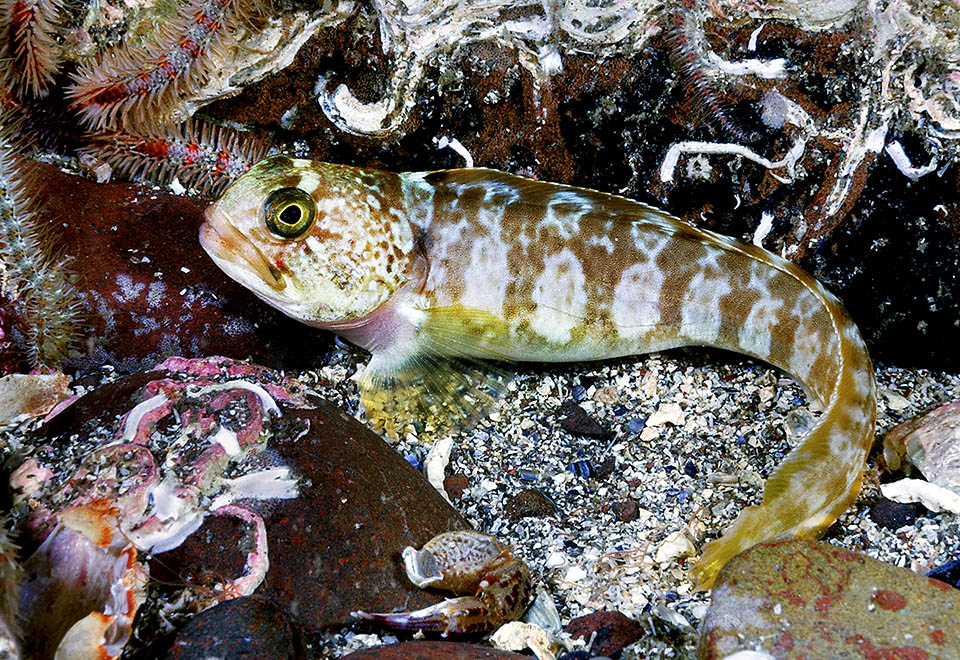
A juvenile. The Atlantic wolffish reproduces when 8-10 years old when it reaches the 50 cm. In nature it may live about 20 years and, captive, exceeds 50 © Jim Greenfield
The resilience of the species is low, with a minimum time for doubling the populations of 4,5-14 years and the fishing vulnerability, high, marks 69 on a scale of 100.
In various locations the populations are decreasing. Anarhichas lupus presently doesn’t appear in the IUCN Red List but in Canada is considered endangered and therefore is a protected species.
Synonyms
Anarhichas lupus lupus Linnaeus, 1758; Anarhichas strigosus Gmelin, 1789; Anarhichas vomerinus Agassiz, 1867; Anarhichas lupus marisalbi Barsukov, 1956.
→ For general information about FISH please click here.
→ For general information about BONY FISH please click here
→ For general information about CARTILAGINOUS FISH please click here.
→ To appreciate the BIODIVERSITY of BONY FISH please click here.
→ To appreciate the BIODIVERSITY of CARTILAGINOUS FISH please click here.
